Learning from the Dead: The Human Postmortem Microbiome Database
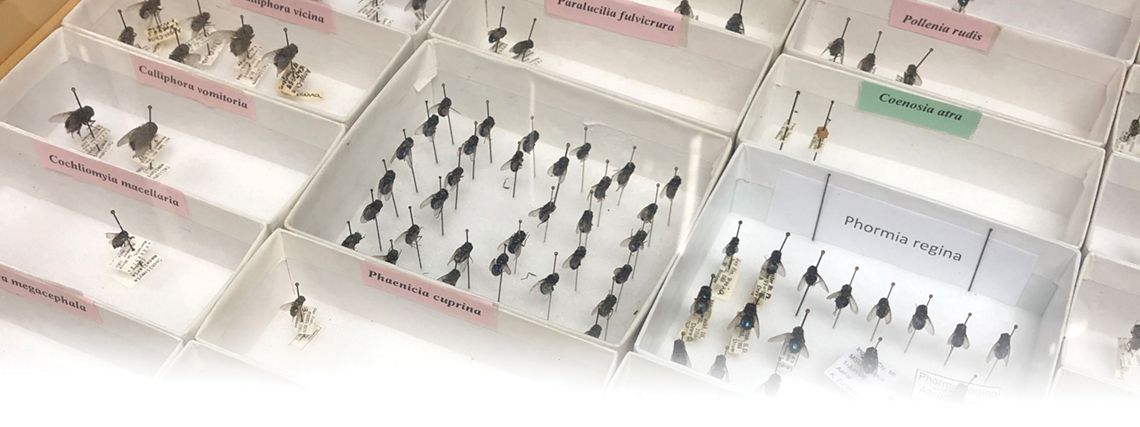
- M. Eric Benbow
- Associate Professor
- Department of Entomology, College of Agriculture and Natural Resources; Department of Osteopathic Medical Specialties, College of Osteopathic Medicine
- Jennifer L. Pechal
- Assistant Professor
- Department of Entomology
- College of Agriculture and Natural Resources
- Carl J. Schmidt
- Chief Medical Examiner, Wayne County
- Associate Professor, Department of Pathology
- University of Michigan
- Heather R. Jordan
- Assistant Professor
- Department of Biological Sciences
- Mississippi State University
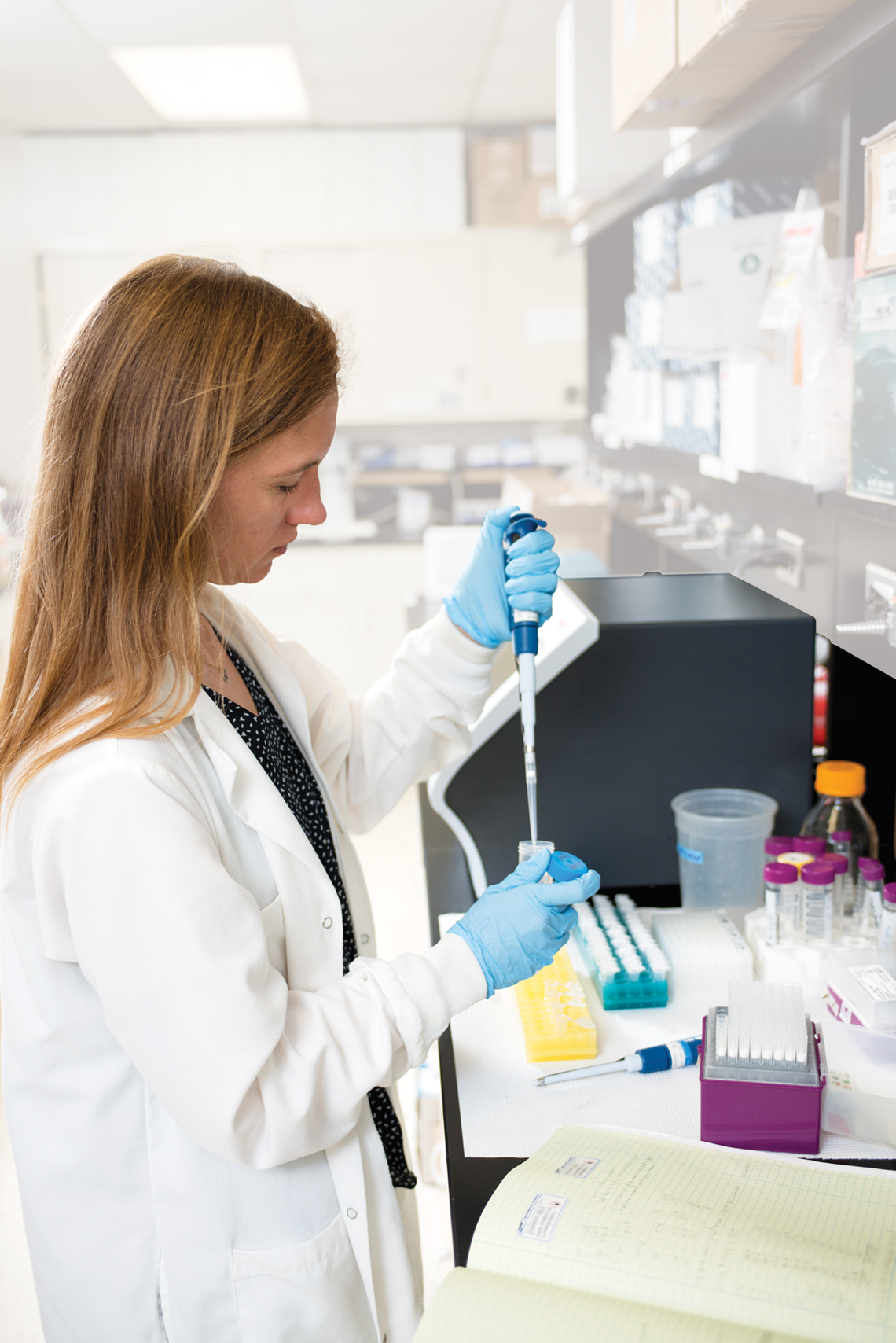
Jennifer Pechal processes microbiome kits.
If you watch NCIS, you probably already know: Forensic entomology—at least the medico-legal aspect of it—deals with evidence gathered by studying the insects that appear at the scene of a crime. In death investigation it is the study of things such as which insects appear, in what order, and their location on the body. This can be helpful in determining the postmortem interval (time elapsed since the decedent died) and location of a death in question.
Forensic ecology widens the scope of study to include microbes and other small creatures that invade a body after death.
Eric Benbow and Jennifer Pechal are forensic ecologists in MSU's Department of Entomology. Benbow's specialization is insect-microbial community ecology and Pechal's is decomposition ecology.
Forensic entomology is a well-established field; less is known about forensic ecology. In fact, Benbow and Pechal are pioneers in this area. "I've been doing this work for over a decade now," said Pechal. "That's what I did my PhD on, how insects and microbes interact on decomposing bodies." Separately and together, the two have produced a number of journal articles over the past few years.
Their goal for this research has been to discover applications for their findings about the postmortem microbiome (the distinct microbial community that forms in response to a shared physical climate, i.e., a corpse), both human and non-human, in the same way that insect activity can reveal important information to a death investigator.
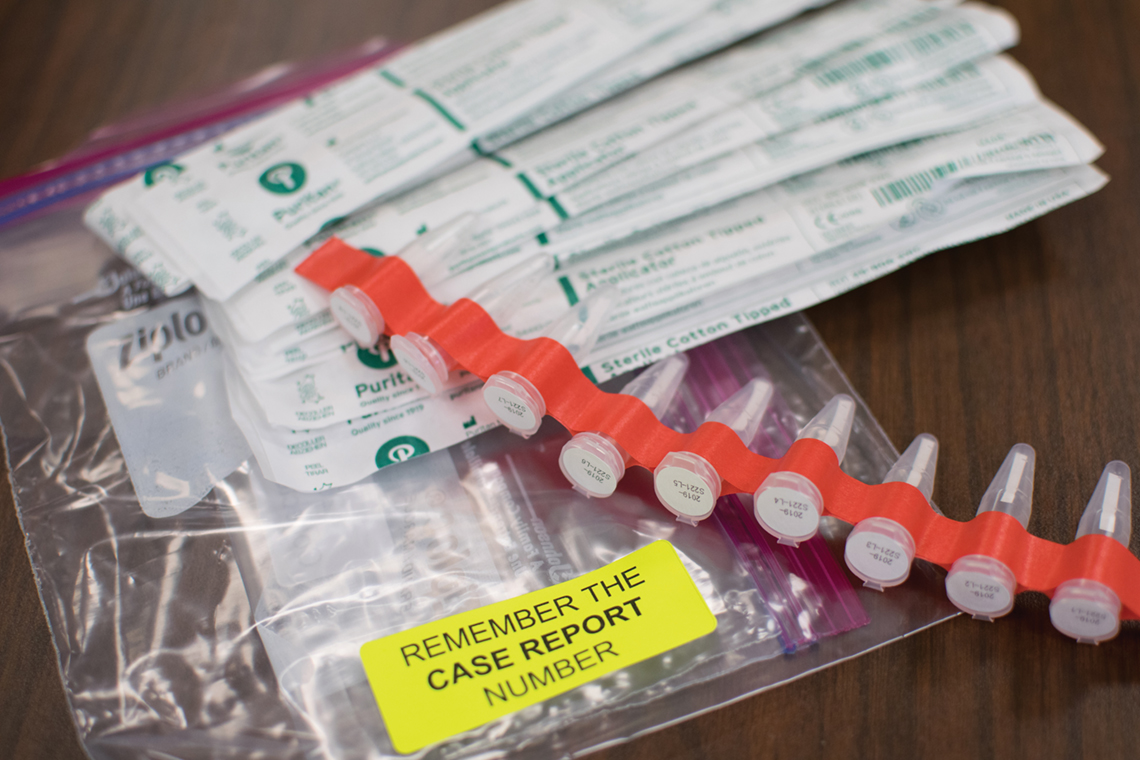
A postmortem microbiome sampling kit.
But the work didn't really take off until 2014, when they met Carl Schmidt at the annual American Association of Forensic Sciences conference. Schmidt is the chief medical examiner for Wayne County, Michigan, and a faculty member with the University of Michigan School of Medicine. After Pechal presented a workshop on the postmortem microbiome, Schmidt approached her about the feasibility of using this information as part of actual death investigation. At that time it had not yet been used outside of the research context.
As a medical examiner Schmidt had the facilities for collecting biological samples, as well as a large specimen base. Benbow and Pechal had done the homework on methodology and data analysis. It was immediately obvious that a collaboration would benefit both parties.
At the same time, they were approached by microbiologist Heather Jordan of Mississippi State University. Jordan was one of the first researchers to ask the question of whether anyone had used microbes in determining time of death.
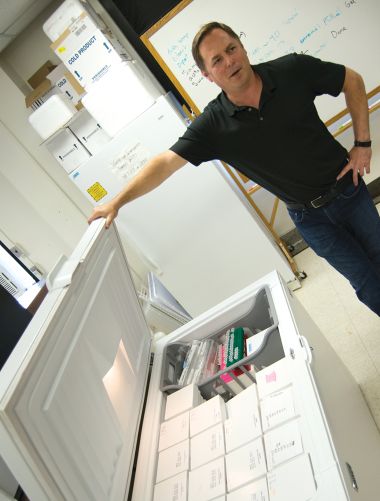
Eric Benbow displays sampling kits—some awaiting analysis, some already processed—which are carefully stored in the lab's freezer.
"I was not familiar with the forensics field very much, so in going into the background of postmortem interval and insects for utility in this, I asked if there had been any previous utilities of microbes for determining postmortem interval or anything else that would be useful for forensic science," said Jordan.
"I remember Eric saying, 'We are talking to a medical examiner here who has some really ground-breaking ideas for large-scale research—we have access to some amazing sample sets'—really, the ideas just sort of came together, of what became the grant. It's an interesting field and I joined the team just as it was becoming a hot topic. People were beginning to appreciate the microbiome for implications of health and the ability of diagnoses beyond disease states. I was intrigued by this, and still am."
The grant was a three-year (2015-2017) award for $886,408 from the National Institute of Justice, "Postmortem Changes and Translocation of Bacterial Community Structure and Function for Use in Criminal Investigations."
Now with a platform for large-scale research and a grant to support it, the team has begun to build their human postmortem microbiome (HPMM) database1, something akin to a postmortem version of the long-running National Institutes of Health's Human Microbiome Project2 to catalog the microbiome of living humans and learn more about its role in human health and disease.
Feeding the Database
The data collection and processing starts at Schmidt's office in Wayne County, with swabbing for bio-samples from several sites on each cadaver that is part of the study. According to Pechal, any one location can contain different microbiomes that are not shared even with other areas of the body. Schmidt and his staff then package and label the samples according to specifications provided by Benbow and Pechal, and deliver them in person to East Lansing.
Pechal oversees the sequencing of the samples, a process that results in a summary of the genetic structure of each microbe, making it available for further analysis and, it is hoped, discoveries important to the ecological, forensic, and medical sciences.
This information is then added to the HPMM database, which currently represents more than 2,300 death investigation cases, with microbiomes characterized from about 10 percent thus far. Samples collected from new cases are added weekly.
There were procedural issues to be worked out. As Schmidt observed, "I had 20 years of experience with research in a medical examiner setting, so I knew what was possible and what wasn't. The first step was thinking about how could we incorporate this into our routine work flow. One of the impediments to doing research in a forensic setting is that you develop efficiencies over time. Those efficiencies are easily broken if you try to add an extra step here or there—which is often what you need to do if you're trying to ask a research question. It interrupts your work flow. So I had to figure out how to incorporate swabbing into a work flow such that it would not interfere with the efficiencies that we have developed over the years to do our casework. And we are a large medical examiner's office, so we get a lot of cases."
The group is currently on a campaign to get more medical examiners on board. Benbow said, "Once we got the work flow going in Carl's office and the data started to come in, we realized a couple of things we needed. We needed more locations both internationally and in the U.S. The Europeans were most receptive to that at first. Colleagues from Austria, France, and Italy agreed to accept our swabs, so we shipped some swabs to them and they processed a number of cases and shipped back some swabs and we processed them. So it's grown from something that was pretty serendipitous to more of a global thing."
Unforeseen Advantages
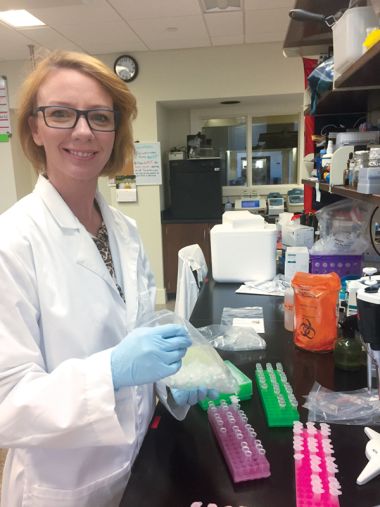
Heather Jordan works in her lab.
Collecting samples from medical examiners has had some unforeseen advantages. Schmidt noted that "our population is not self-selecting in the way that many research projects have to deal with. The typical research subject who volunteers...They tend to belong to a particular demographic. They are educated, they have money, they're not representative of the general population. Whereas the reason you end up in a place like mine is because life took a turn for the worse and you couldn't do anything about it. It just happens. So we have a broad range, from infants all the way up to very elderly individuals, and it provides an opportunity to understand the microbiome in a way that you don't have in any other setting."
Antibiotic resistance is one area of interest that has turned up. One of Jordan's students at Mississippi State, Zachary Burcham, recently did some work evaluating antibiotic resistant genes from samples taken during a routine autopsy. Benbow said, "Basically we can now identify whether or not and what diversity of antibiotic resistant genes are circulating in the human population. And that's valuable."
Schmidt added, "There are antibiotic resistant genes out there, in people who have never received the antibiotic that might promote the expression for that particular gene. Which is actually pretty scary, if you think about it."
Key Findings
One of the team's most valuable findings is that the microbiome doesn't change much for the first 48 hours postmortem. This is the reason that autopsy samples can be evaluated for things like antibiotic resistance the same as if they came from living samples. Unlike other measures that are currently used to estimate time of death, this timing appears to be independent of circumstances like whether the body is situated in a hot, cold, dry, or wet place.
"This means that for two days we have a snapshot of what your microbiome was at the moment you were still living," said Schmidt. "And if you can harness that and glean information that is not discoverable in any other way, it would be diagnostically useful. We come across a whole lot of people of whom we know nothing about their past medical history. One of them is a microbiome profile that is consistently appearing in diabetics (we think) or heart disease; we're not yet sure which it is. In the absence of any other medical information we could do a microbiome profile and be able to say with some certainty that you were a diabetic before you died, that maybe some of the pathological changes that we're seeing are due to diabetes."
Pechal noted that in the living microbiome studies that have been performed, different areas on the body ("we've got about nine different areas that we're sampling from right now") have different microbial communities: "But even after 48 hours we still see those very distinct microbial signatures. They persist even after death, which again highlights the usefulness of these bacteria for different questions that may arise, either medical-history-wise or forensically.
"Technologies continue to improve," she said, "so our methods that we're using right now are great for these times. But we may be able to increase our accuracy for the postmortem interval or perhaps circumstances of death if we continue to use better sequencing tools, better statistical analyses, better modeling approaches. It's a constantly moving process."
And, from working with the international communities, she added, "We are seeing some interesting trends as to overall country differences based on the microbiome. We're still parsing those out right now, but hopefully we'll have a publication submitted in the next month or so."
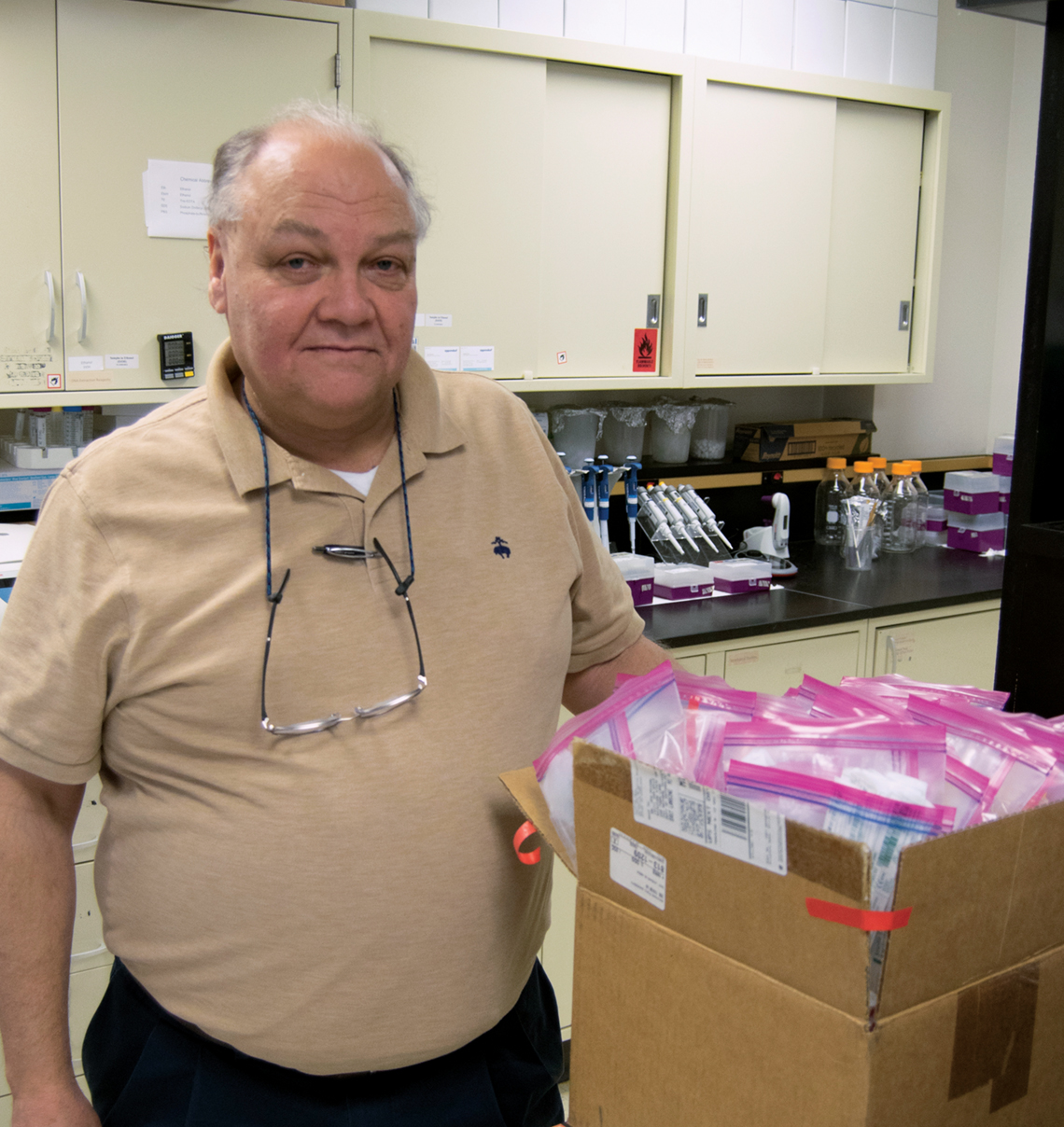
Carl Schmidt, Wayne County medical examiner, picks up microbiome kits from Benbow's lab.
Schmidt said, "That would have huge forensic significance. Say you found somebody in Detroit who was actually killed in Flint. It would be cool to be able to say oh, he's originally from Flint, or he was in Flint long enough for his microbiome to become a Flint microbiome."
But Pechal cautioned, "Body area is the biggest factor still. Regardless of where your death location is, your body sites are still going to be much different from each other."
The Linchpin
Thanks to Benbow, Pechal, Jordan, Schmidt, and their colleagues, the language of science has a new term: necrobiome, the full community of organisms associated with a decaying body3. The study of the interactions within that community is only a few years old, but is already yielding interesting and useful results.
So far as Benbow knows, this perspective is unique to their research team. "A medical examiner, a microbiologist, a decomposition ecologist and entomologist, and basically a community ecologist have come together. That's the linchpin here," he said. "And that's what a microbiome is, it's a community of organisms that you have to be able to properly sample for those communities. You have to properly be able to get them sequenced, and interpret the data, and then interpret the forensic or the medical significance of that community of organisms and how they assemble or disassemble in different ways."
Sources
- See https://hpmmdatabase.wixsite.com/hpmmdatabase/ Back to Article
- See https://www.hmpdacc.org/hmp/overview/ Back to Article
- Benbow, M.E., & Pechal, J.L. (2015). Microbial interactions of the necrobiome: Basic research and forensic applications. Microbiologist, 16(3), 26-29. Back to Article
- Written by Linda Chapel Jackson, University Outreach and Engagement
- Photographs courtesy of Heather Jordan and Paul Phipps, University Outreach and Engagement